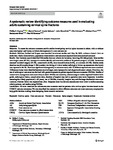A systematic review identifying outcome measures used in evaluating adults sustaining cervical spine fractures
| dc.contributor.author | Copley, PC | |
| dc.contributor.author | Tadross, D | |
| dc.contributor.author | Salloum, N | |
| dc.contributor.author | Woodfield, J | |
| dc.contributor.author | Edlmann, Ellie | |
| dc.contributor.author | Poon, M | |
| dc.contributor.author | Khan, S | |
| dc.contributor.author | Brennan, PM | |
| dc.date.accessioned | 2022-11-02T10:58:17Z | |
| dc.date.issued | 2022-09-05 | |
| dc.identifier.issn | 1432-0932 | |
| dc.identifier.issn | 1432-0932 | |
| dc.identifier.uri | http://hdl.handle.net/10026.1/19822 | |
| dc.description.abstract |
<jats:title>Abstract</jats:title><jats:sec> <jats:title>Objective</jats:title> <jats:p>To assess the outcome measures used in studies investigating cervical spine fractures in adults, with or without associated spinal cord injury, to inform development of a core outcome set.</jats:p> </jats:sec><jats:sec> <jats:title>Methods</jats:title> <jats:p>Medline, Embase and Scopus were searched for relevant studies until May 28, 2022, without a historic limit on study date. Study characteristics, population characteristics and outcomes reported were extracted and analyzed.</jats:p> </jats:sec><jats:sec> <jats:title>Results</jats:title> <jats:p>Our literature search identified 536 studies that met criteria for inclusion, involving 393,266 patients. Most studies were single center (87.3%), retrospective studies (88.9%) and involved a median of 40 patients (range 6–167,278). Treatments assessed included: surgery (55.2%), conservative (6.2%), halo immobilization (4.9%), or a mixture (33.2%). Median study duration was 84 months (range 3–564 months); the timing of clinical and/or radiological follow-up assessment after injury was reported in 56.7%. There was significant heterogeneity in outcomes used, with 79 different reported outcomes measures. Differences in use were identified between smaller/larger, retro-/prospective and single/multicenter cohorts. Over time, the use of radiological outcomes has declined with greater emphasis on patient-reported outcome measures (PROMs). Studies of conservative management were more likely to detail PROMs and mortality, whereas surgical studies reported Frankel/ASIA grade, radiological fusion, complication rates, duration of hospital stay and re-operation rates more frequently. In studies assessing the elderly population (> 65 years), use of PROMs, mortality, hospital stay and discharge destination were more common, whereas fusion was reported less often. Response rates for outcome assessments were lower in studies assessing elderly patients, and studies using PROMs.</jats:p> </jats:sec><jats:sec> <jats:title>Conclusions</jats:title> <jats:p>We have classified the various outcome measures used for patients with cervical spine fractures based on the COMET outcome taxonomy. We also described the contexts in which different outcomes are more commonly employed to help guide decision-making when designing future research endeavors.</jats:p> </jats:sec> | |
| dc.format.extent | 3365-3377 | |
| dc.format.medium | Print-Electronic | |
| dc.language | en | |
| dc.language.iso | eng | |
| dc.publisher | Springer | |
| dc.subject | Cervical spine | |
| dc.subject | Core outcome set | |
| dc.subject | Fracture | |
| dc.subject | Outcomes | |
| dc.subject | Spine surgery | |
| dc.subject | Systematic literature review | |
| dc.title | A systematic review identifying outcome measures used in evaluating adults sustaining cervical spine fractures | |
| dc.type | journal-article | |
| dc.type | Systematic Review | |
| dc.type | Journal Article | |
| dc.type | Review | |
| plymouth.author-url | https://www.webofscience.com/api/gateway?GWVersion=2&SrcApp=PARTNER_APP&SrcAuth=LinksAMR&KeyUT=WOS:000851250300001&DestLinkType=FullRecord&DestApp=ALL_WOS&UsrCustomerID=11bb513d99f797142bcfeffcc58ea008 | |
| plymouth.issue | 12 | |
| plymouth.volume | 31 | |
| plymouth.publication-status | Published | |
| plymouth.journal | European Spine Journal | |
| dc.identifier.doi | 10.1007/s00586-022-07369-7 | |
| plymouth.organisational-group | /Plymouth | |
| plymouth.organisational-group | /Plymouth/Faculty of Health | |
| plymouth.organisational-group | /Plymouth/Faculty of Health/Peninsula Medical School | |
| plymouth.organisational-group | /Plymouth/REF 2021 Researchers by UoA | |
| plymouth.organisational-group | /Plymouth/REF 2021 Researchers by UoA/UoA01 Clinical Medicine | |
| plymouth.organisational-group | /Plymouth/Research Groups | |
| plymouth.organisational-group | /Plymouth/Research Groups/FoH - Applied Parkinson's Research | |
| plymouth.organisational-group | /Plymouth/Research Groups/Plymouth Institute of Health and Care Research (PIHR) | |
| plymouth.organisational-group | /Plymouth/Users by role | |
| plymouth.organisational-group | /Plymouth/Users by role/Academics | |
| plymouth.organisational-group | /Plymouth/Users by role/Researchers in ResearchFish submission | |
| dc.publisher.place | Germany | |
| dcterms.dateAccepted | 2022-08-25 | |
| dc.rights.embargodate | 2022-11-3 | |
| dc.identifier.eissn | 1432-0932 | |
| dc.rights.embargoperiod | Not known | |
| rioxxterms.versionofrecord | 10.1007/s00586-022-07369-7 | |
| rioxxterms.licenseref.uri | http://www.rioxx.net/licenses/all-rights-reserved | |
| rioxxterms.licenseref.startdate | 2022-09-05 | |
| rioxxterms.type | Journal Article/Review |


